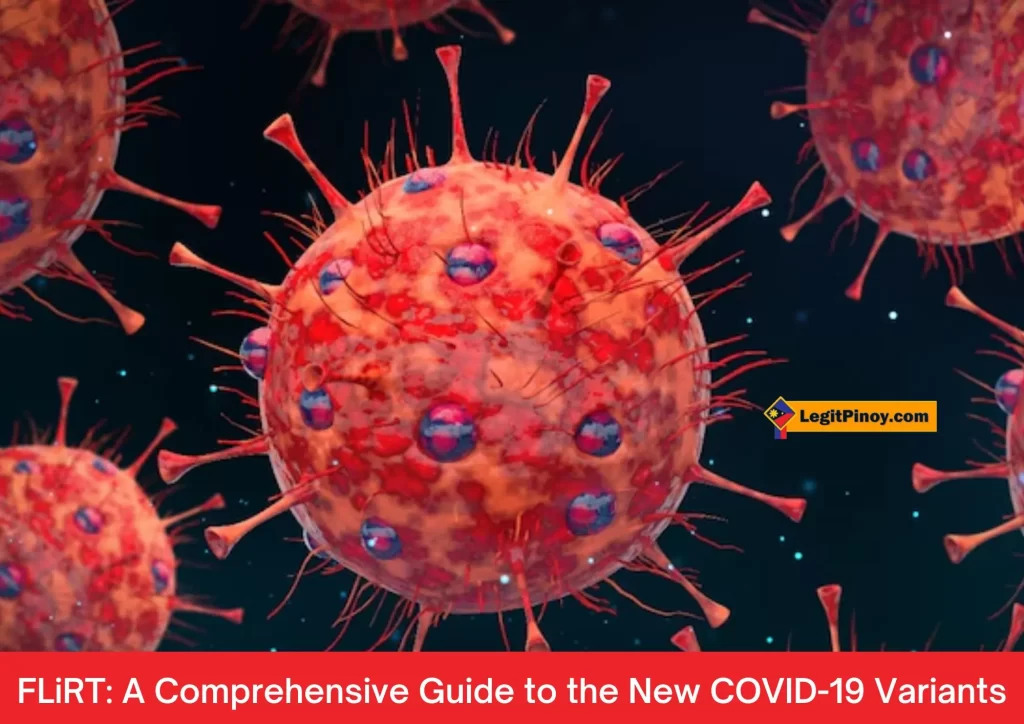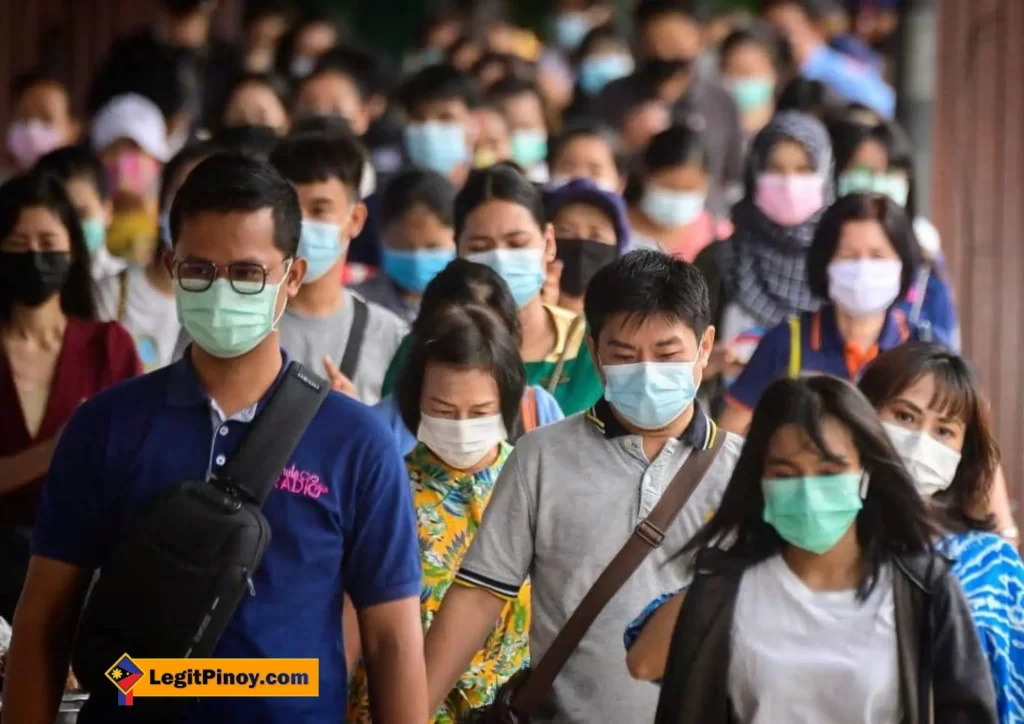FLiRT: A Comprehensive Guide to the New COVID-19 Variants

FLiRT: New Covid-19 Variant explore an in-depth exploration of the latest mutation. Gain insights into their potential impact on public health measures!
Advertisement

Introduction
COVID-19, caused by the SARS-CoV-2 virus, emerged in late 2019 and quickly became a global pandemic. It primarily spreads through respiratory droplets and close contact with infected individuals. Symptoms range from mild to severe and include fever, cough, fatigue, and difficulty breathing. To combat the pandemic, vaccines were developed and distributed worldwide, offering protection against severe illness and death.
Throughout the pandemic, several variants of the SARS-CoV-2 virus have emerged, characterized by mutations in their genetic code. These variants often exhibit differences in transmissibility, severity of illness, and potential evasion of immunity from previous infection or vaccination. Some notable variants include Alpha (B.1.1.7), Beta (B.1.351), Gamma (P.1), and Delta (B.1.617.2).
Understanding FLiRT
Understanding hypothetical variants like FLiRT (Frequent Low-intensity Respiratory Transmission) involves considering potential characteristics based on theoretical scenarios. While FLiRT is not an actual variant of the SARS-CoV-2 virus, discussing it can help illustrate the importance of monitoring and studying new variants.
The FLiRT variant is a made-up concept to imagine what a hypothetical version of the COVID-19 virus might be like. It stands for “Frequent Low-intensity Respiratory Transmission.” We use it to talk about a situation where the virus spreads easily between people but might not make them very sick. While FLiRT isn’t real, thinking about it helps us prepare for possible changes in the virus and how to respond to them.
🦠 Transmission Dynamics: FLiRT may be characterized by frequent but low-intensity respiratory transmission. This means that it spreads easily between individuals but may not necessarily cause severe illness or result in high hospitalization rates. Understanding this transmission pattern is crucial for assessing the overall impact on public health and healthcare systems.
🦠 Clinical Manifestations: Given its low-intensity transmission, FLiRT may present with mild symptoms or even be asymptomatic in many cases. This aspect could make it challenging to detect and control compared to variants that cause more severe illness, as individuals may not realize they are infected and continue to spread the virus unknowingly.
🦠 Vaccine Evasion: While FLiRT may not necessarily evade immunity from vaccination entirely, it could potentially pose challenges in terms of vaccine effectiveness. Variants that cause milder illness may still lead to breakthrough infections in vaccinated individuals, highlighting the importance of ongoing vaccination efforts and possibly the need for booster doses to enhance immunity against emerging variants.
🦠 Public Health Response: Understanding FLiRT and similar hypothetical variants underscores the need for robust surveillance systems and adaptive public health strategies. Even if a variant does not cause widespread severe illness, its high transmissibility could still lead to significant community transmission if left unchecked. Therefore, proactive measures such as testing, contact tracing, and targeted interventions may be necessary to prevent outbreaks and control transmission.
🦠 Future Preparedness: While FLiRT may be a theoretical concept, it highlights the ever-evolving nature of infectious diseases and the importance of preparedness for emerging threats. By studying hypothetical variants and their potential characteristics, researchers can anticipate future challenges and develop strategies to mitigate their impact on public health.
Genetic characteristics and mutations
As FLiRT is a hypothetical variant, it doesn’t have specific genetic characteristics or mutations. However, if we were to speculate on its genetic makeup, it might have mutations that allow for increased transmissibility while potentially causing milder symptoms compared to other variants. These mutations could affect various parts of the virus’s genome, such as the spike protein, which plays a crucial role in viral entry into cells and immune recognition. Again, it’s important to note that FLiRT is a theoretical concept used for discussion purposes rather than a real variant with identified genetic mutations.
Comparison with other known COVID-19 variants
| Characteristic | FLiRT Variant | Alpha Variant (B.1.1.7) | Delta Variant (B.1.617.2) |
|---|---|---|---|
| Transmission | Frequent, low-intensity | High | Very high |
| Severity of Illness | Mild | Moderate to severe | Moderate to severe |
| Symptoms | Often mild or asymptomatic | Similar to original strain | Similar to original strain |
| Vaccine Evasion Potential | Low | Some reduced efficacy possible | Some reduced efficacy possible |
| Transmissibility Impact on Public Health | Moderate | Significant | Very significant |
Remember, FLiRT is a hypothetical variant, so its characteristics are speculative. Actual variants like Alpha and Delta have been identified and studied extensively, contributing to our understanding of COVID-19’s evolution.
Transmission and Spread
FLiRT, being a hypothetical variant, is conceptualized to exhibit frequent but low-intensity respiratory transmission. This means it could spread easily between individuals, possibly through respiratory droplets, but may not cause severe illness or lead to high rates of hospitalization.
The spread of FLiRT could be akin to a common cold or mild flu, where infected individuals might not realize they’re sick or have only mild symptoms, potentially making it more challenging to detect and control compared to variants causing more severe illness. However, its ease of transmission could still contribute to community spread if not managed effectively through public health measures such as testing, contact tracing, and vaccination.
FLiRT: Factors contributing to the rapid transmission

🦠 High Infectivity: FLiRT might possess genetic mutations that enhance its ability to infect cells and replicate rapidly within the host, leading to higher viral loads and increased shedding of the virus, thereby facilitating its spread to others.
🦠 Asymptomatic Transmission: Individuals infected with FLiRT may not exhibit noticeable symptoms or may only experience mild symptoms, allowing them to unknowingly spread the virus to others, particularly in settings where asymptomatic transmission is common.
🦠 Short Incubation Period: FLiRT may have a shorter incubation period compared to other variants, meaning individuals become infectious soon after exposure, increasing the likelihood of transmission before symptoms develop or are recognized.
🦠 ariability in Viral Shedding: FLiRT could exhibit variability in viral shedding patterns, with some individuals shedding higher viral loads for longer durations, increasing the chances of transmission to others, especially in close-contact settings.
🦠 Potential Immune Evasion: While FLiRT is speculated to cause milder illness, it may still possess mutations that allow it to evade immune responses to some extent, potentially leading to reinfections or breakthrough cases in previously infected or vaccinated individuals, contributing to ongoing transmission.
🦠 Behavioral Factors: Social and behavioral factors, such as relaxed adherence to preventive measures like mask-wearing and physical distancing, increased travel and mobility, and gatherings in indoor settings with poor ventilation, could further facilitate the rapid spread of FLiRT within communities.
Clinical Impact

The clinical impact of the hypothetical FLiRT variant, characterized by its speculated milder illness compared to variants like Alpha and Delta, would likely manifest in several distinct ways. With its tendency to cause less severe symptoms, FLiRT could lead to fewer hospitalizations and decreased rates of mortality among infected individuals.
This reduced severity could also alleviate the burden on healthcare systems, sparing resources for other medical needs and potentially mitigating the strain experienced during surges in COVID-19 cases. However, the mildness of FLiRT’s symptoms may pose challenges in detection and diagnosis, as individuals may not recognize their illness as COVID-19 and therefore may not seek testing or medical care promptly.
Consequently, there is a risk of underestimating FLiRT’s true prevalence and impact on public health, particularly if surveillance systems primarily rely on symptomatic cases for detection. Despite its mild clinical presentation, ongoing monitoring of FLiRT’s long-term health implications, such as the potential for persistent symptoms (long COVID) or complications, would be essential to fully understand its ramifications.
Additionally, assessing FLiRT’s impact on vaccine effectiveness and the need for booster doses or adjustments to vaccination strategies would be crucial to ensure continued protection against emerging variants.
Future Outlook
Looking ahead, the hypothetical FLiRT variant presents both opportunities and challenges in the ongoing battle against COVID-19. Its speculated milder illness could offer a reprieve from the severe cases and strain on healthcare systems seen with other variants. This could lead to a gradual return to normalcy, with fewer hospitalizations and a reduced sense of urgency surrounding pandemic response measures. However, the mildness of FLiRT’s symptoms may also foster complacency, potentially hindering efforts to maintain vigilance and control over the virus’s spread.
Additionally, the possibility of underestimating FLiRT’s prevalence and impact highlights the need for robust surveillance and monitoring systems capable of detecting and responding to emerging threats swiftly. Furthermore, ongoing research into FLiRT’s long-term health implications, vaccine effectiveness, and potential for mutation and evolution remains essential to inform future public health strategies. Ultimately, while FLiRT’s hypothetical characteristics may offer some respite, continued diligence and adaptability will be crucial in navigating the evolving landscape of the COVID-19 pandemic.
Conclusion
In conclusion, the FLiRT variant serves as a hypothetical lens through which we explore the potential trajectory of the COVID-19 pandemic. Speculated to cause milder illness compared to other variants, FLiRT offers a glimpse of a future where the severity of the disease may diminish. While this could alleviate pressure on healthcare systems and signal a return to normalcy, it also poses challenges in detection and response, potentially leading to complacency and underestimation of its impact.
To navigate this uncertain terrain, continued surveillance, research, and adaptability will be essential. Vigilance in monitoring FLiRT’s prevalence, understanding its long-term implications, and assessing its effects on vaccine effectiveness will guide our response strategies. As we move forward, it’s imperative to remain proactive, flexible, and united in our efforts to overcome the challenges posed by COVID-19 and its potential variants.
You May Also Like
Advertisement

- Celtics Vs. Heat Game
- Toni Fowler’s pregnancy
- Heatwaves in the Philippines: Impact to Students
- Sarah Duterte
- Mobile Legends New Hero: Chip
- Demon Slayer: Hashira Training Arc
- Asoka inspired makeup: San sanana Trend on Tiktok
- Labor Rights
- Diwata Pares received 1 million pesos and house and lot from Rosmar
- Kaila Estrada’s acting skills is on fire
- David Corenswet as superman
- Mother’s Day 2024
- High Street
We also recommend the following:

Jill Lynn is a versatile blogger and content creator who loves writing about a variety of topics. From travel and lifestyle to food and wellness, she shares her experiences and insights with readers around the world. With her authentic voice and engaging storytelling, Jill has built a strong online presence and a supportive community of followers. Her passion for writing and dedication to producing quality content continue to inspire others on their own journeys.
